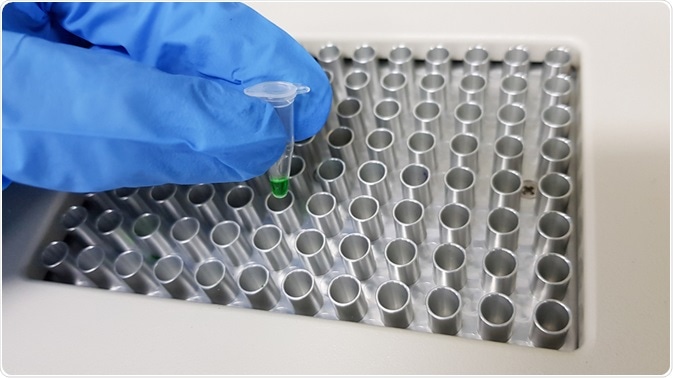There are several molecules that may degrade the DNA and interfere with the PCR reaction. PCR inhibitors may bind to DNA polymerase, interact with DNA itself, or interact with DNA polymerase during primer extension.

Putita | Shutterstock
DNA Polymerase inhibitors
The ratio of protein and DNA is highly skewed in human blood; for every 1µl of blood, there is about 35ng of protein, which can interfere with the polymerization process. Heme, a component of hemoglobin, has also been shown to inhibit PCR. This is due to the release of iron ions, which affect the pH of the reaction, and disrupt the polymerase activity, probe and primers. For this reason, heme is often regarded as a universal PCR inhibitor.
It has been widely observed that hemoglobin disrupts PCR after being disintegrated by proteinase K, while there is no effect from non-digested hemoglobin. Melanin is another melabolite known to inhibit Taq polymerase. Increasing the concentration for Taq polymerases has been proposed for humic acids that inhibit PCR.
Nuclei acid inhibitors
Nucleic acids inhibit the primer annealing or extension, and thus, affect the melting point or conformation of DNA. Immunoglobulin G (IgG) was found to form a complex with single stranded DNA and inhibit PCR. It has been found that though Taq polymerase, Ampli Taq, Pwo cannot amplify DNA in the presence of IgG, the Tth enzyme still can.
Fluorescence inhibitors
In real-time PCR, inhibitors that can affect the fluorescence signal are present. This is due to changes in the ion concentration, or the binding and quenching of fluorophores. Humic acids sequester ethidium bromide and reduce DNA interaction. This effect increases with increase in tube length and lower volume, so those great care should be taken with those factors.
PCR Buffers
BSA is a common PCR facilitator. It can bind to fatty acids and organic molecules and this binding ability can reduce inhibition during in vitro amplification. It can also bind to inhibitors, such as heme and melanin and prevent them from binding to the DNA polymerase.
In the presence of BSA, inhibitors such as phenols bind to BSA instead of polymerase. Different concentrations of BSA have been tested to reduce the inhibition effect.
Apart from BSA, inorganic detergents, such as tween 20 and triton X are also used to facilitate the amplification step. Among organic solvents, DMSO and formamide are used to reduce the inhibition. Biologically compatible solutes, such as betaine and glycerol, and polymers, including PEG and dextran are often used.
Sampling methods that affect PCR reliability
Good sampling methods can also reduce the PCR inhibition effects. During forensic DNA analysis, the sample DNA size may be very small, and there may a presence of high background, for example waste water. For this purpose, direct sampling, where the material is directly placed in the treatment tube to increase the number of target cells, is used.
Surface swabbing can also be used to reduce the levels of PCR inhibitors that may be present in the substrate. The swabs can also be moistened using saline to improve the cell recovery. Nylon swabs may also be used to increase the cell number.
Pre-PCR processing
The inhibitors to PCR may enter at different steps of the PCR process–sampling, sample treatment and PCR. This can be reduced by using DNA polymerases that are heat stable and PCR facilitators. Pre-PCR processing allows samples with high analytical precision to be generated.
Further Reading